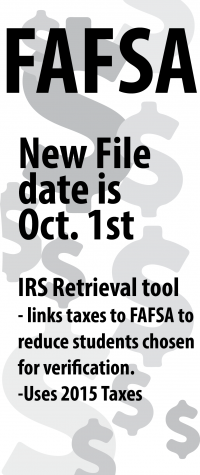Key changes to FAFSA pushes filing date up
October 19, 2016
The process for students to apply for federal aid for the 2017-2018 school year has changed from previous years.
The biggest changes to the Free Application for Federal Student Aid (FAFSA) is the timeline for filing and receiving aid.
The filing process for federal aid for next fall began on Oct.1,instead of the previous date of Jan. 1. By making the deadline sooner, aid will reach students earlier. This will help students and their families plan financially for the upcoming school year.
The tax information the government will use to determine a student’s financial need has also changed. The process now requires students and their families to use tax information that was filed the previous tax season.
Previously, they were asked to estimate their taxes and income rates of the current year or wait until their taxes were filed. The new process will help take any guess work out of the process, which will help ensure students financial situation is more accurately accounted for.
“That is going to be very helpful because then you’re going to use the preceding two years worth of taxes,” Carol Miller, Director of Financial Aid said. “In other words, you filed this year using 2015 taxes, you’re going to do the same thing for next year.”
Linking FAFSA
A filing process to help students has been created, the Internal Revenue Service (IRS) retrieval tool. This tool links a student’s application to their family’s tax information to ensure all income information will be transferred directly and the income and tax information is correct .
“So when we look at that, we know ‘hey, this family they’re alright we don’t really have to do much’ because we know that you used the IRS retrieval tool, so we know your information is accurate,” Miller said.
This tool is designed to help lower the number of students chosen for the verification process, where the university would request further income or tax information. When chosen for verification, aid can take longer to reach
the student.
“It’s going to help somewhat, it’s not going to clear up all of those clarifications,” Miller said. “If you’re chosen for verification rather than having to then contact the IRS to get a copy of your federal tax transcript, you don’t have to, because you’ve utilized that tool.”
Admissions
With the new FAFSA changes, aid will be reaching students in a more timely manner, which means new students will be able to make a more informed and accurate decision of which college they will attend, and returning students will be more accurately able to decide how to pay for
the coming year.
These changes could be a factor in the growth of the University’s population, although that will remain unclear until the National Candidate Reply date on May 1, 2017, which is the national deadline new students must inform universities of attendance.
“Our application numbers compared to last year are almost exactly the same, they’re not up they’re not down,” Jeremy Reed Director of Admissions said. “It just remains to be seen if they’ll be an impact on students that
ultimately enroll.”













